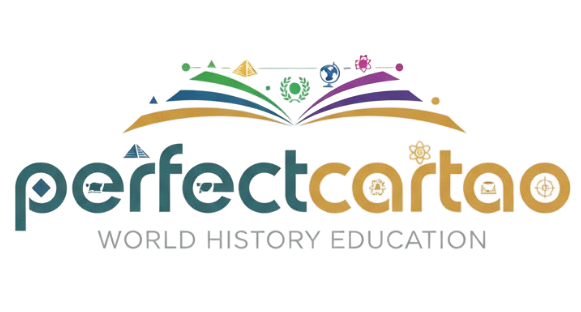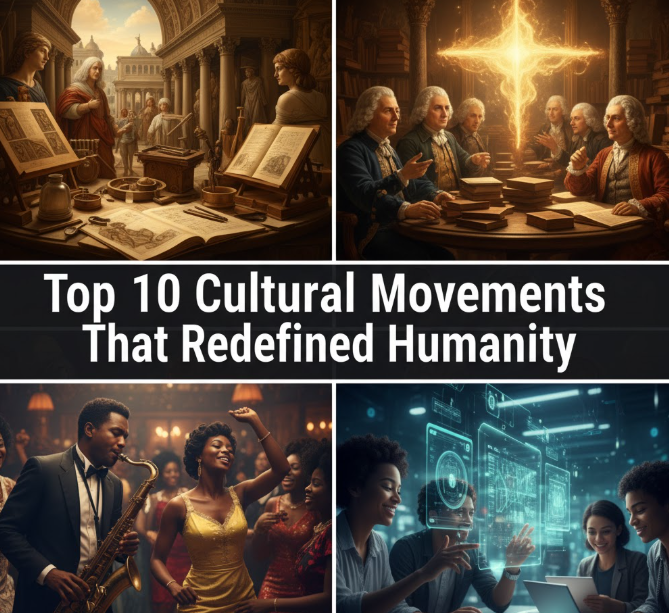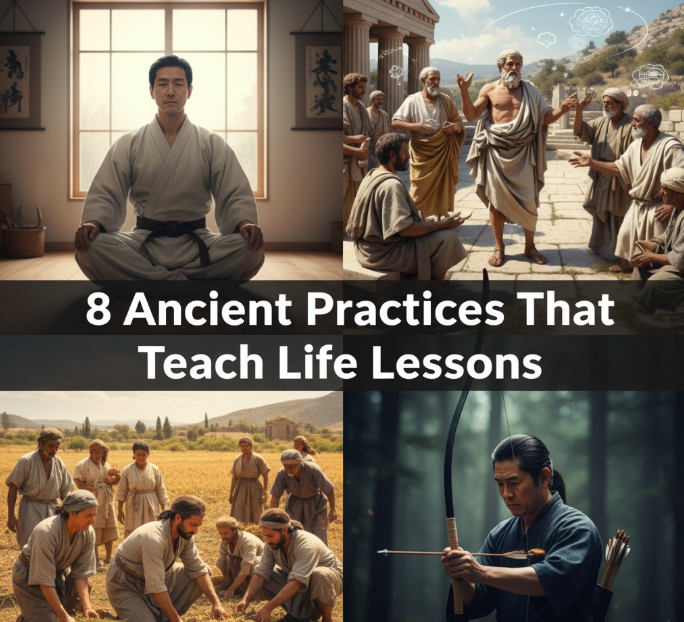At various points throughout history, certain cultural movements have revolutionized processes of thought, belief and creation. Those weren’t just fads turning over — they were imposing forces that remade art, music, politics and society. From the rediscovery of classical learning to the rise of cognitive science, these movements have formed the world we live in. We will look at ten of the most significant cultural movements that have significantly impacted human life and still affect us to this day in a million different ways.
The Renaissance: When Europe Rediscovered the Potential of Humans (14th-17th Century)
Started in Italy in the 1300s, and within decades spread like a wildfire throughout all of Europe. “Renaissance,” in fact, means “rebirth,” and that’s what took place. After centuries of living with medieval attitudes, people began peering back into the ancient Greek and Roman understanding about art, science and human achievement.
Why It Mattered
Artists such as Leonardo da Vinci and Michelangelo didn’t just paint beautiful pictures; they also learned anatomy, mathematics and perspective in order to create effectively realistic art. Scientists like Galileo began to doubt ancient teachings and to experiment to find out how the world really works. Writers wrote in the language of everyday life, rather than just in Latin — which means regular people could read what was being produced.
The lesson of the Renaissance is that reason, observation, and creativity can enable mankind to reach great heights. That movement is the basis of science, art and democratic thought as we know them.
Real-World Impact
- Medical textbooks with realistic pictures of the human body
- Art techniques that changed not just painting, but also education today
- The scientific method used in all modern research
- Buildings that were beautiful and accurate-looking
The Enlightenment: Reason Rules (17th-18th Century)
Called The Age of Reason, the Enlightenment was when European thinkers decided that what would drive human progress should be logic and evidence—not simply tradition or religious edict. The philosophers John Locke, Voltaire and Jean-Jacques Rousseau raised larger questions about government, freedom and human rights.
The Ideas That Sparked Revolutions
Enlightenment philosophers thought everybody was naturally endowed with certain rights including life, liberty, and the pursuit of happiness. They said that governments should exist to serve the people, not the other way around. These weren’t hollow ideas; they were the direct inspiration for both the American Revolution and French Revolution.
The Enlightenment spawned modern democracy, human rights and the idea that education should be open to all. It questioned churches. It challenged kings. And it placed citizens at the heart of political life.
Key Contributions
| Area | Enlightenment Innovation |
|---|---|
| Politics | Democracy and constitutional government |
| Science | Organized scientific societies and journals |
| Philosophy | Individual rights, social contracts |
| Education | Public schools, universal literacy efforts |
Romanticism: Emotions Strike Back (Late 18th-Mid 19th Century)
After all that Enlightenment reason and logic, along with a Descartes-inspired appreciation for skepticism, Romanticism said “Wait a minute what about feelings?” This group valued emotion, nature, imagination, and each other’s experiences. Romantic poets, novelists and musicians thought feelings were just as important as using your reason.
The Heart Over the Head
Poets such as William Wordsworth wrote about their lives and childhood in a flurry of nature. Composers from Beethoven onward had written the musical expression of powerful emotion. Painters like Caspar David Friedrich depicted tiny humans overpowered by expansive mountains and stormy seas.
The romantics have reminded mankind that we’re not simply thinking machines. Our feelings, our dreams and our relationship with nature matter profoundly. It was a movement that impacted environmental preservation to contemporary methods of therapy.
What Romanticism Brought Us
- National pride, and cultural identity movements
- Horror and gothic literature (hello Frankenstein)
- Emotion in music and art
- Valuing the environment and nature
The Industrial Revolution’s Cultural Side: Modernism Emerges (Late 19th-Early 20th Century)
As factories, railroads, cities flipped reality on its head, artists & thinkers created Modernism to deal with these crazy fast-moving times. Modernists rejected tradition and tested new forms of expression.
Breaking All the Rules
Painters such as Pablo Picasso shattered realistic art with Cubism, which showed things from more than one angle at once. Writers such as James Joyce sought to record in real-time the way thoughts arise. Architects such as Le Corbusier built sleek structures for functional ends.
Modernism was an art of response to a world that seemed to be changing more rapidly. It welcomed technology, and urban life, and psychological complexity. The movement was a challenge against everything people thought they knew about art and culture.
Modernist Innovations
- Abstract art, which did not try to look like anything outside of itself
- Experimental literature that used new narrative techniques
- Functional architecture that didn’t have time for frills
- New jazz music that defied traditional musical rules

Top 10 Cultural Movements That Redefined Humanity
The Harlem Renaissance: Black Culture Takes Center Stage (1920s-1930s)
In the uptown neighborhood of New York City called Harlem, a black cultural renaissance took place, setting the stage for the civil rights movement. This movement also demonstrated that Black culture was not simply the equal of white culture — it was alive and daring, essential to American life.
Voices That Could Not Be Stifled
Writers such as Langston Hughes and Zora Neale Hurston celebrated Black experiences with unabashed pride. Musicians like Duke Ellington and Louis Armstrong redefined jazz. Artists including Aaron Douglas produced visual art that linked African ancestry with contemporary Black life.
The Harlem Renaissance transformed American culture and led to decades of activism for civil rights. It proved the power of cultural expression as a force for social change.
Legacy of the Movement
- Jazz had become America’s most important musical export
- Black literature was incorporated into mainstream schooling
- New pride in African American identity and heritage
- Platform for later civil rights activism
Surrealism: Dreams Make Art (1920s-1940s)
Surrealism applied imagery from dreams, subconscious mind and irrational side of human experience. A group of artists led by figures such as Salvador Dalí and René Magritte, the Surrealists produced strange dreamlike images that encouraged viewers to think differently about reality.
The Logic of Dreams
Surrealists drew on the thinking of Sigmund Freud regarding the unconscious. They thought dreams and imagination could open one to truth more deeply than reason could. Their paintings included melting clocks, floating apples and incongruous objects mashed together.
This movement changed what art could be and do. It shaped advertising, film, fashion and psychology. Surrealism prompted people to remember that human experience has its mysteries, is irrational and inscrutable, involved in the creepy realm of dreams.
Why It Still Matters
- Influenced modern advertising and visual design
- Broadened the definition of what cinema, photography and art in general could look like
- Linking art to psychology and the unconscious
- Inspired future movements such as Pop Art and conceptual art
The Counterculture Movement: Youth Rebellion Goes Mainstream (1960s-1970s)
The ’60s counterculture movement was when young people across the Western world rejected traditional values and adopted the kind of lifestyles their parents were revolted by. This counterforce was anti-war and pro-peace-love, playful in new forms of community and insistent on social justice.
A Generation Suspects It All
Young people rebelled against the Vietnam War, fought for civil rights and questioned sexual mores. Musicians such as Bob Dylan and The Beatles wrote music that constituted anthems for social change. It was an era that saw hundreds of thousands unite to celebrate music, peace and community at events like Woodstock.
The counterculture revolutionized fashion, music, sexual politics and ideas about gender, power and consciousness. It made a popular cause of environmental protection, organic food and personal spiritual exploration.
Long-lasting Changes
| Before the Counterculture | After the Counterculture |
|---|---|
| Formal dress codes | Casual, individual expression |
| Rigid gender roles | Questioning traditional roles |
| Conformity valued | Individuality celebrated |
| Limited environmental awareness | Environmental movement begins |
Punk Rock: DIY and Rebellion (1970s-1980s)
Originating in the mid 1970s, punk rock was a primitive and brash reaction both to mainstream rock music as well as widespread social issues. Punk bands from The Ramones to the Sex Pistols to The Clash played fast, straight-to-the-point music with angry, direct lyrics about unemployment, social issues and a lack of connection.
Much More Than Music
Punk was a full-fledged cultural revolution, with its own fashions (ripped clothing, leather jackets, safety pins), art (cut-and-paste graphics) and philosophy (do it yourself). Niche punks began putting out records, opening clubs and publishing magazines because mainstream culture refused to pay them any attention.
The punk ethos — that anyone could make without permission or expensive equipment — inspired countless musicians, artists and activists. Punk’s DIY spirit still fuels today.
The Punk Legacy
- Independent Music and The Zine Culture
- Anti-Establishment Political Activism
- Fashion that Celebrated Individualism & Rebellion
- Proof That Cultural Movements Can Start at the Margins
Hip-Hop Culture: From the Streets to the World (1970s-Present)
Hip-hop started in the Bronx, New York, during the 1970s as a cultural movement encompassing rapping (MC’ing), DJing, breakdancing and graffiti art. For what has spread from street parties to be arguably the world’s most influential cultural force today?
The Genre That Changed Music Forever
Hip-hop gave a voice to marginalized communities, and in doing so, it instigated a revolution in music. DJs such as Kool Herc established means of looping breaks and scratching records. MCs rhythmically fashioned words into complex beats. B-boys developed athletic dance styles. Graffiti writers turned cityscapes into galleries.
Hip hop culture has inspired various elements including fashion, language, and business, while also having an influence on general popular culture. It is the soundtrack of the 21st century and it morphs with each generation.
Hip-Hop’s Global Impact
- World’s most popular music genre
- Fashion trends that are an influence on some of the world’s biggest brands
- New poetry and wordplay forms
- Youth empowerment and entrepreneurship
- Social commentary around inequality/injustice
The Digital Information Age: When Culture Engages with Technology (1990s-Present)
The internet and digital technology have created a cultural revolution as big as when we invented the printing press. The digital revolution has altered the way we make, share and consume culture. Anyone with an internet connection is now a creator, not merely a consumer.
A Cultural Movement
Online social networks give artists, musicians and others the ability to reach a worldwide audience instantly. Streaming services revolutionized the way we watch movies and listen to music. Memes became a new means of culture. And then there were online communities for every interest you could imagine.
The Internet age put culture in the hands of ordinary people like no movement before it. It also raised new issues about privacy, misinformation and screen addiction. This movement still is unfolding, and its eventual impact is unknown.
How Digital Culture Changed Everything
- Anyone can be a creator and publisher
- Global communities form around shared interests
- Cultural trends spread worldwide instantly
- New art forms like digital art and video games
- Constant connection and information access
What These Movements Teach Us
Looking across these ten cultural movements we see some patterns in how cultures change. Movements often start in the margins — in small cities or among youth and less notorious groups. They question the established power and ways of thinking. They offer new means of self-expression and interpretation of the world to people.
Cultural movements remind us that society is not fixed. If enough people adopt new ideas, make new art or demand change, then they can reshape civilization itself. Each movement contained building blocks of the ones preceding them, as well as reactions against them. The Renaissance looked to antiquity for wisdom. The Enlightenment emphasized reason. Romanticism reintroduced emotion into the equation. And so forth, an ongoing discussion across the centuries.
Learn more about the impact of cultural movements on modern society.
Why This Still Matters
When we are living through our own cultural shifts, it is easy to dismiss such critiques as old-fashioned and fusty. The political response to climate is giving rise to a new culture. The social justice movements are just the latest in a series that are recasting conversations about equality. Technology is still redefining the way we relate to each other and culture more broadly.
Through the study of past cultural movements, we make sense of what’s going on around us. Indeed, we are able to follow as specific artists, intellectuals and activists facilitated broader shifts. We can acknowledge that culture is a moving target — it is always created, ridiculed and reinvented.
These ten show that human creativity and the need for change never go out of style. Whether through Renaissance art, Enlightenment philosophy, punk rock rebellion or digital innovation, people have never stopped finding ways to expand their definition of what it means to be human.
The next big cultural movement could be beginning at this moment, in someone’s garage, on someone’s home computer or from somewhere we may not have heard of yet. That’s the one beautiful thing about cultural movements — they crop up when people have the temerity to think differently, to create fearlessly, to dream about new possibilities for humanity.

Frequently Asked Questions
What is meant by a cultural movement, exactly?
A cultural movement happens when a large group of people have a lot of new ideas about art, music, politics, or society that catch on and change things for even some people. They tend to consist of artists, writers, musicians and thinkers who work in similar ways or toward similar ends.
What is the shelf life of a cultural movement?
Nearly everything positive or negative that we attribute to these major cultural movements can be measured in decades at most, and once the movement wanes there is barely a trace of it left few generations later (with a couple exceptions). Some movements, such as hip-hop, have been alive for more than 40 years and continue to develop.
How do cultural movements take place without the technology or social media?
Absolutely. Many of the movements on this list preceded the internet by decades. Cultural movements were transmitted by word of mouth, printed material, exhibits, performances and people traveling in order to share ideas. Technology makes the process faster but is not a necessity.
Do cultural movements have to be progressive (or liberal)?
No, cultural movements can emerge from any corner of the political landscape. Though most movements in this list are considered radical, not all (such as nationalism, patriotism and representative democracy) have been considered by liberals or progressives to be illegitimate.
How do cultural movements start?
Cultural movements usually develop when a small group of creative people in a particular place begin to exchange similar ideas and work in similar ways. It only builds as others come along to join or adopt its tenets. Sometimes there is a particular event, art work or publication that serves as a catalyst.
So what is the difference between a cultural movement and a trend?
Trends are short-term shifts in fashion or popularity that typically don’t materially alter how people think. Cultural movement is a symbolic shift of values, beliefs, thoughts and ultimate aspired activation within the community.
Why do some movements in culture take off while others fizzle?
Effective movements generally touch upon actual societal problems or desires, and they provide appealing new visions at the right moment in time. And they need dedicated advocates and effective strategies for getting out their message. Very few possible movements go on to gain critical mass and bring about long-lasting change.
Is there any big cultural move happening right now?
Yes, there are other big cultural movements going on right now too. We have climate activism, we have digital and AI art production, we have various social justice movements – in short there’s the continued reshaping of culture controlled by internet type tech. It’s generally easier to spot and name movements after they have matured.




